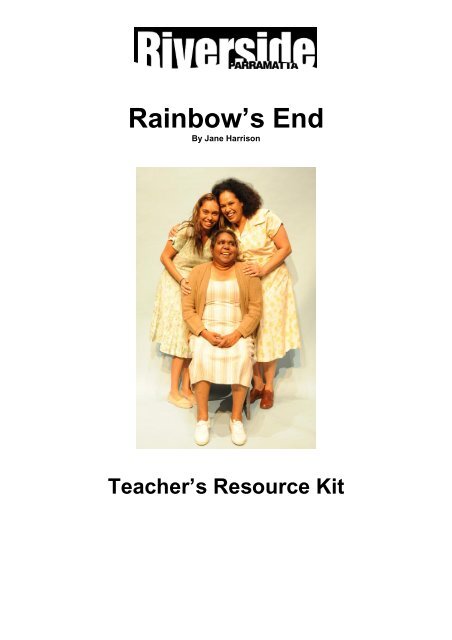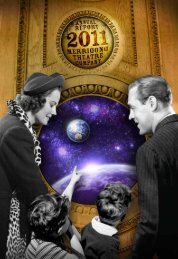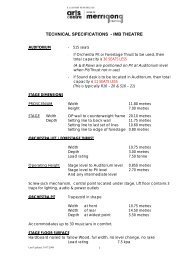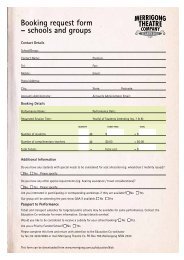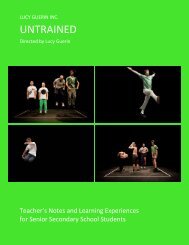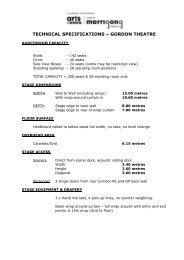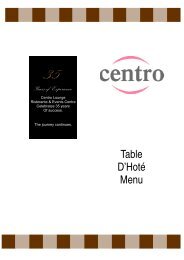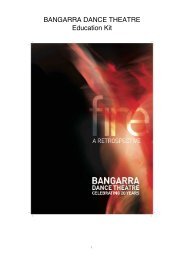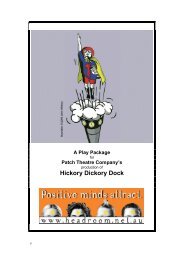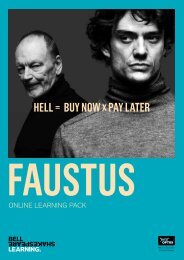Rainbow’s End
Download - Merrigong Theatre Company
Download - Merrigong Theatre Company
- No tags were found...
You also want an ePaper? Increase the reach of your titles
YUMPU automatically turns print PDFs into web optimized ePapers that Google loves.
<strong>Rainbow’s</strong> <strong>End</strong><br />
By Jane Harrison<br />
Teacher’s Resource Kit
Contents:<br />
The ‘<strong>Rainbow’s</strong> <strong>End</strong>’ cast and crew 3<br />
Transcript of interview with playwright Jane Harrison 4<br />
Further reading and suggested learning activities based on<br />
Jane’s interview 6<br />
Transcript of interview with director Craig Ilott 8<br />
Further reading and suggested learning activities based on<br />
Craig’s interview 9<br />
Articles- Investigations into Indigenous Housing:<br />
Living in a town like Shep (The Age) 10<br />
History of Rumbalara (HealthInfoNet) 15<br />
After a life of loss, a housing legacy of Shame (Weekend<br />
Australian) 17<br />
Further reading- Modern Day Indigenous Issues:<br />
The New Stolen Generation (Weekend Australian) 19<br />
2
<strong>Rainbow’s</strong> <strong>End</strong>- Cast and Crew<br />
Cast<br />
Gladys Banks<br />
Nan Dear<br />
Dolly Banks<br />
Errol Fisher/Males<br />
Christine Anu<br />
Lillian Crombie<br />
Chenoa Deemal<br />
TBC<br />
Voices on the radio<br />
Ross Higgins, Heather Mitchell, Jamie Oxenbold, Alice Parkinson<br />
Creative Team<br />
Director<br />
Set Designer<br />
Costume Design<br />
Lighting Design<br />
Composer<br />
Sound Design<br />
Production Stills<br />
Production Coordinator<br />
Producer<br />
Craig Ilott<br />
Jacob Nash<br />
Rita Carmody<br />
Matthew Marshall<br />
Steve Francis<br />
Jeremy Silver<br />
Branco Gaica<br />
Sean Clarke<br />
Camilla Rountree<br />
Production Thanks:<br />
3
Transcript of Interview with Jane Harrison<br />
Riverside Theatres- July 2009<br />
Please note- this article is hyperlinked for interactive learning.<br />
Download an electronic copy from:<br />
http://www.riversideparramatta.com.au/performance.asp?pID=840<br />
Download a video of this interview from:<br />
http://www.youtube.com/watch?v=BXne7NwsCXI<br />
Q: Where did the story for <strong>Rainbow’s</strong> <strong>End</strong> come from?<br />
Rainbows <strong>End</strong> came out of commission by Ilbijerri who were the only<br />
Aboriginal and Torres straight islander theatre company in Melbourne. They<br />
asked a number of writers to write about a decade of Victorian Koori history,<br />
in particular to write about the ‘heroes’ of that era. Of course there were a lot<br />
of real life heroes that I could have written about (people like William Cooper<br />
and Pastor Doug Nicholls, people of that ilk), however, I only had eight weeks<br />
to come up with the first draft and to do a lot of that research would have<br />
taken a bit longer so I decided to write a fictional account and to write about<br />
[the time when] the men were off and away doing great work in the wider<br />
community [while] the women were often left behind keeping the family and<br />
keeping the food on the table and those kind of things. I decided the real<br />
heroes to me where the women who were keeping the families together and<br />
that everyday struggle they had, particularly living in that area around the river<br />
near Shepparton, the area called ‘The Flats’. It was about those women living<br />
on the outskirts of town and the day to day struggles they had.<br />
Q: What do you want audiences to get out of your play?<br />
In some ways, writing a historical play (because it is set around the 50’s and it<br />
does have a few real life incidences- like the Queen’s visit and the<br />
development of the housing around that area called Rumbalara- it is based on<br />
some historical facts) but it is a historical play so in a way it’s a little bit of a<br />
peep hole into that era. And it’s not so long ago, you know, it’s a little bit<br />
before my time but it’s still in living history so it’s really interesting to see how<br />
times have changed and some of the conditions that people had to live in<br />
there, living in humpies beside the river and the fact that there was no welfare<br />
and the fact that there was no support and that a lot of people had to do very<br />
menial labour because there weren’t the opportunities for education<br />
(aboriginal people were kind of locked out of a lot of those opportunities). So I<br />
think it’s fascinating that we have moved quite a long way but in some ways<br />
there are residences with some things that are happening currently- I suppose<br />
the Northern Territory interventions are another modern day equivalent of that<br />
kind of intervention with Aboriginal people’s lives. So I suppose I just want to<br />
get an insight, and also, the richness of their family life I think is important for<br />
audiences to see, because although they didn’t have the material things they<br />
had each other, they had a very supportive family life and they were very<br />
connected as a family, they’re a lovely family to me and I hope audiences<br />
respond to their warmth and the characters.<br />
4
Q: Is the story uniquely Australian or do you think international<br />
audiences will identify with it?<br />
Well the play actually has had a season in Japan, in Tokyo, there’s a small<br />
theatre company there that has done a couple of Aboriginal plays, quite a few,<br />
so how an aboriginal play transfers to another country is always really<br />
interesting cause there is a lot of vernacular in the play, there’s a lot of slang,<br />
there’s a lot of local references and a lot of stories that make sense for that<br />
area and that time, so actually translating that to another language is a<br />
challenge. But I think what people respond to is their humanity and just the<br />
family life so I think an audience from overseas can, you know, see the beauty<br />
of their relationships and I think that’s fairly universal. I felt the same with<br />
[another of my plays] Stolen, I actually didn’t see <strong>Rainbow’s</strong> <strong>End</strong> in Japan so I<br />
don’t exactly know how the audiences responded to it but I was in Japan<br />
when Stolen played there and, again, the universality of those kind of<br />
circumstances came through, people could always find something to relate to<br />
in the characters.<br />
Q: Each of the characters goes on a journey. Can you describe them?<br />
The basic story is about three generations of aboriginal women living on the<br />
flats beside the river, living in a humpy. There’s Nan Dear, her daughter<br />
Gladys and then the granddaughter, Gladys daughter, Dolly, so it’s about their<br />
world. Papa Dear, who’s Nan Dear’s husband is off doing good work, he’s a<br />
pastor, so we don’t see him really (he’s referred to quite a lot but we don’t see<br />
him on the stage) and the only other outsider character who comes in is Errol<br />
who’s an encyclopaedia salesman and he (it’s a bit of a 50’s love story) he<br />
does fall in love with Dolly, and they have their journey, their relationship<br />
journey. I think all of them go through a bit of a journey and it’s about finding<br />
their own voice, particularly with Gladys, I don’t want to give too much away<br />
about Gladys’ character but to me she’s a really powerful woman who just<br />
doesn’t realise how strong she is and what a contribution she can make and I<br />
think hopefully by the end of the play we’re all cheering on Gladys! And I think<br />
for Errol being a non-indigenous character I think that’s an interesting journey<br />
too because at one stage he, again without giving too much of the story away,<br />
he’s offering her, Dolly, a better world and he has to come to the realisation<br />
that in fact their world, although it doesn’t have as many material things as the<br />
world he comes from, their world has another richness which is in their family<br />
relationships and he has to meet them halfway if he’s to be part of their family,<br />
so he goes on that journey. I think Dolly is a young character, she goes on an<br />
enormous journey really, at the beginning of the play she’s very close to her<br />
grandmother, Nan Dear, and mother, she’s kind of a bit caught between both<br />
of their desires for her, she has to find her own voice and make her own<br />
choices in life and I think she does that by the end of the play. It’s got some<br />
lovely music in it from the 50’s, it is a bit of a love story, but I think it’s also<br />
telling a bigger story about some of the challenges aboriginal people faced in<br />
that time and how resilient and strong they were and how they just did what<br />
they had to do to keep the family together.<br />
5
Q: Do you think the issues raised in the play for Aboriginal people in the<br />
1950’s still exist today?<br />
I think a lot of the issues that faced people then we’re still facing, maybe not<br />
so much in the urban areas but certainly in parts of Australia, things like the<br />
town camp situation in the Northern Territory, not that I’m an expert on that,<br />
but I think there’s resonances really with how aboriginal people still aren’t in<br />
control of their own destiny, self determination is still something we’re fighting<br />
for, still having to fight those battles for self determination. And there’s a<br />
patriarchal approach to aboriginal people that we’re still in many communities<br />
being treated as children who don’t know how to look after our own best<br />
interests, or we don’t have the answers, and I think aboriginal people do have<br />
the answers and need to be listened to and considered rather than sending in<br />
the army to “fix up” the aboriginal problem. I mean, again, in the fifties and<br />
that story in the play about the inspector coming in that was based on real<br />
circumstances that happened in Victoria and I think those things are still<br />
happening where we’re being assessed and judged and then there’s an<br />
“aboriginal problem” that white people need to solve.<br />
Further reading and suggested learning activities:<br />
⇒ The 1950’s in Australia: Indigenous and non-indigenous Australians<br />
lived and belonged to two very different worlds in the 1950s (as<br />
demonstrated by Errol and Dolly in the play).<br />
o The non- indigenous Australia<br />
o The Indigenous Australia<br />
Suggested activity: After reading these webpages, why not try writing a<br />
creative writing piece, describing the 1950’s Australia through the eyes of<br />
an indigenous teenager like Dolly.<br />
⇒ After the 1950’s- the move towards citizenship: The 1967<br />
Referendum bridged some of the gap between these worlds, and some<br />
of the rights that heroes like Papa Dear were fighting for were closer to<br />
being a reality.<br />
Suggested activity: Does citizenship alone make a group of people really<br />
belong to a country or society? What needs to happen to achieve a true<br />
sense of belonging? Write your response to these questions, with<br />
reference to the play “<strong>Rainbow’s</strong> <strong>End</strong>” and what you know of the 1967<br />
Referendum.<br />
6
⇒ Beyond the referendum- Indigenous Affairs up to today: There<br />
have been a number of significant events in Australia since the 1967<br />
Referendum that have been milestones for Indigenous Australians.<br />
Read about the following three events at these links:<br />
o 1972: The erection of the Aboriginal Tent Embassy<br />
o 1992: The MABO Case (navigate through this entire website to<br />
get the most information)<br />
o 2008: Prime Minister Kevin Rudd says Sorry to the<br />
aboriginal people who were part of the Stolen Generations<br />
Suggested activity: There are quite a few events not listed above. Using<br />
the internet, do your own research and compile a timeline of significant<br />
events for Indigenous Australians from 1967 to today.<br />
Disclaimer- Riverside does endorse the content on the external web pages provided as<br />
hyperlinks in this document. These notes are compiled for education purposes only.<br />
7
Transcript of Interview with Director<br />
Craig Ilott<br />
Riverside Theatres- August 2009<br />
Please note- this article is hyperlinked for interactive learning.<br />
Download an electronic copy from:<br />
http://www.riversideparramatta.com.au/performance.asp?pID=840<br />
Q: What first attracted you to the play?<br />
What first attracted me to the play? It’s heart, I think. I think when I initially read it<br />
I was a little but concerned that I was a white fella reading an Indigenous work<br />
and by an Indigenous writer and I was a bit nervous about that and about what I<br />
perceived at that point may be politics. But I had a chat to a couple of people<br />
about it, people that I trust, and it seemed to be the thing to sort of go for and that<br />
it was okay. But as to the play it was certainly the heart, I think there’s such a<br />
beautiful heart beating at the centre of it.<br />
Q: How did you first approach the text?<br />
How did I first approach the text? Well, initially, I am very sort of keen on a long<br />
design process, but I read the play again and again and again and then I guess<br />
there’s a fair deal of daydreaming- all those things we were as kids not to do, it’s<br />
a terrific thing from an artists point of view, from a director’s point of view. So I<br />
read it over and over again and then I am also sort of big on collaboration so the<br />
first conversations that I really had with anyone about it were with Jake Nash the<br />
set designer. We had numerous chats about all sorts of things in and around the<br />
text and there was a long design process there and then an audition process and<br />
further chats with Riverside and with [the producer] Camilla [Rountree] and you<br />
sort of get a bit closer to finding the cast and the design and so it’s a long process<br />
over three or four months of reading and chatting to people about it and ‘how<br />
could we view this moment’ and ‘what’s important’. So that’s probably it, that long<br />
design process.<br />
Q: What do you think audiences will get out of the play?<br />
I think hope is the key, sort of, after taste I guess at the end, of some<br />
reconciliation. I think also that they’ll feel (I feel it anyway) an incredible sense of<br />
admiration of the women in this play, the sort of heroicism and stoicism of these<br />
three women. The play is written around (Jane, I think you had an interview with<br />
Jane but) three indigenous women in the 50’s in Melbourne, well Shepparton-<br />
Mooroopna. So I think that’s what we’re left with- the strength of these women<br />
and the courage of these women and the ability, that they were able to find a way<br />
to sort of empower themselves at a time that was a very difficult time I guess for<br />
Indigenous Australians.<br />
8
Q: Thinking of the issues raised in the play, do you think it could be set in<br />
2009?<br />
You know, it’s a controversial question and I personally think yes, I think without a<br />
doubt it’s still potent and pertinent. I think there has been a great distance that<br />
we’ve travelled as a nation but I still think that there’s still great inequality and still<br />
great problems there. Yeah I do still think that it’s still very, very potent and<br />
pertinent.<br />
Further reading and suggested learning activities:<br />
⇒ The Process and the People: As Craig explained above, the director<br />
undertakes a long process of collaboration with other members of the<br />
creative and production team to bring a play to life. There are hyperlinks in<br />
Craig’s interview to sites explaining the role of a director, producer and set<br />
designer. Read the following sites about the other major roles in the<br />
theatre<br />
o Actor<br />
o Costume Designer<br />
o Stage Manager<br />
o Lighting Designer<br />
o Sound Designer<br />
Suggested activity: Pretend you have been given the role of either set<br />
designer, costume designer, lighting designer or sound designer for this<br />
production of “<strong>Rainbow’s</strong> <strong>End</strong>”. Write a 1 A4 page pitch to Craig, telling him<br />
what your design concept would be for this production and how your design<br />
will look for the major scenes on stage.<br />
Disclaimer- Riverside does endorse the content on the external web pages provided as<br />
hyperlinks in this document. These notes are compiled for education purposes only.<br />
9
Online Newspaper Article<br />
Link: www.theage.com.au/national/living-in-a-town-like-shep-20080711-3dsa.html?page=-1<br />
Living in a town like Shep<br />
Les Briggs at home with his family. Photo: John Woudstra<br />
Jo Chandler<br />
July 12, 2008<br />
Victoria's Aborigines live far from the dust stirred by the intervention, but also face bleak realities. Amid the<br />
hardship, however, is hope.<br />
AS A TEENAGER in the late 1950s, Les Briggs lived in an Aboriginal shanty town wrought from old tin and ingenuity<br />
on the banks of the Goulburn just outside Shepparton. When the river rose, the fringe-dwellers shifted to higher<br />
ground — a rubbish tip across the causeway. When young Queen Elizabeth drove by in 1954, local lore has it that<br />
her sensibilities (and those of the local burghers) were spared by the draping of a hessian screen along the length of<br />
the bridge. In their way "they were good days", he says. "Uncomplicated."<br />
More than 50 years later, at the age of 66, Les Briggs finally has a home of his own. Last month, helped by a subsidy<br />
from a locally grown pilot Shared Responsibility Agreement, he co-signed a mortgage with his son Doug and gained<br />
title to 1.6 hectares of land on the Murray that he long considered his by right.<br />
He'd rented the property with his late wife, Lorraine, from the Rumbalara Aboriginal Co-operative for a decade — the<br />
tenancy translating to an almost 20% discount on the value of the property under the pilot, which he could then draw<br />
as equity for a deposit. But as a Yorta Yorta man, his claim goes back much further. The irony of buying white man's<br />
title to land denied him through a landmark native title case is acknowledged with a shrug of hard-earned equanimity.<br />
"This is like a buy-back scheme."<br />
What does owning the house mean? "It means the world," is Briggs' instant, emphatic response. "To have security, a<br />
place for all the family to go to." He has seven surviving children and 27 grandchildren. In the way of Aboriginal<br />
family, waves of them will occupy his house.<br />
A mortgage goes against the grain in some ways, he says. "As an Aboriginal person, you live for the day." But<br />
acquiescence to this fundamental of "Western ways" is, he says, a down payment on gaining his grandchildren a<br />
better future in a society where the odds remain stacked against them. Where the bleak truths of Aboriginal life in<br />
Victoria remain screened from view.<br />
10
Most Aborigines live a long way from the dust stirred up by the Northern Territory intervention. But the bleak reality of<br />
their expectations for health, education and employment is not so distant from that of the most remote communities.<br />
The invisibility of local Aborigines, hidden by regional prosperity and an enduring social apartheid only now beginning<br />
to fracture, is remarked upon by community leaders white and black. Shepparton City chief executive Bob Laing, a<br />
Kiwi import who is still surprised at the chasm between Maori and Aboriginal circumstance, questions how the<br />
broader community has for so long been "so accepting about such social disadvantage".<br />
Though it is home to Victoria's largest Koori community, "there are people in Shepparton who would not have had<br />
contact with an Aboriginal person", says local indigenous leader (and Les' younger brother) Paul Briggs. A one-day<br />
spot audit of all the major supermarkets, chain stores and banks in town a couple of years ago found not one<br />
Aborigine among 221 front-of-house workers. "That diminishes us, and diminishes our relationship."<br />
These days local Aboriginal reality is as often as not obscured by public preoccupation with the gross hardships of<br />
life in remote communities in the red centre and the far north, where the news crews, politicians and football teams fly<br />
when they want to engage with, as Paul Briggs puts it, "real blackfellas". In fact, as confirmed by new Australian<br />
National University modelling, 43% — and growing — of Aboriginal people live in places such as Shepparton: rural<br />
and regional towns. By comparison, 15% live in places such as Mutitjulu, and another 8% in far-flung outstations.<br />
Measuring distance between Aboriginal reality in the Northern Territory and in northern Victoria is a slippery<br />
business. It can seem as far apart as the map decrees when you stand on the earth floor of the tiny concrete house<br />
maintained as a museum piece in the grounds of the Rumbalara Aboriginal Co-operative — first-generation, stateowned<br />
Aboriginal housing circa 1958. The old house is disconcertingly similar to those occupied by many Northern<br />
Territory Aborigines.<br />
Such accommodation has long since been left behind in Shepparton, and yet distance vanishes when you compare<br />
the graphs plotting the journey from birth to death of Victorian Aborigines against those who live in the Territory.<br />
Bearing in mind that the NT has an overall Aboriginal population more than twice that of Victoria, the percentage of<br />
low-birthweight babies born to Aboriginal mothers in Victoria is not only much higher than non-Aboriginal numbers, it<br />
is also comparable to the NT rate: 12.75% compared to 13.3% in 2003. By 2006, in Victoria, it was 13.4%, almost<br />
double that of non-Aboriginal Victorian mothers.<br />
New state figures show the gap between the life expectancy of Aboriginal and non-Aboriginal Victorians has grown.<br />
They predict Aboriginal children born this decade (to 2006) will have 19 fewer years than other Victorians — boys<br />
living to 60 compared with 79; girls to 65 compared with 84. Aboriginal men in the NT have even grimmer prospects<br />
(57.6 years). But it's noteworthy that the gaps between indigenous and non-indigenous life expectancy are much<br />
larger in Victoria than the most recent NT figures (2001), where the difference was 13.2 years for males, and 11.3 for<br />
females.<br />
On the question of child welfare and safety — the core concern of the NT intervention — latest Victorian figures show<br />
the number of Aboriginal children found to be in need of protection, following an investigation, is more than 10 times<br />
that of the non-Aboriginal population, despite a significant drop in the past few years. Felicia Dean, who as chief<br />
executive of Rumbalara Aboriginal Co-operative oversees a range of welfare programs, believes the safety of<br />
Victorian Aboriginal children is as fragile as that of children in the north, primarily due to neglect. She is also<br />
concerned that the slowness of an overstressed system is putting children at even greater risk.<br />
Continue to paint by numbers across a range of benchmarks defining quality of life, and the emerging picture is<br />
frequently as dark for Victoria as for remote communities. Kindergarten participation rates are low and declining.<br />
Staggeringly high rates of mental illness afflict Aboriginal men and women. Alcohol-related hospital admissions for<br />
Aboriginal men are 10 times the rate of non-Aboriginal admissions, for drugs the difference is fivefold. Loss of<br />
Aboriginal students at year 10 in Victoria is, with NSW, the worst in the nation.<br />
In Shepparton, a Melbourne University study published last year found the average Koori student was leaving school<br />
before the end of year 8, and by year 12 less than one-quarter were still at school. At the primary level many<br />
struggle, Achievement Improvement Monitor testing showing they typically lag six months behind in numeracy and<br />
literacy.<br />
Prospects beyond school are dismal. While north-east Victoria has the lowest unemployment rate in the country, at<br />
2.3%, the Shepparton Aboriginal jobless rate is almost 10 times that. An extrapolation of a local survey and case files<br />
kept by Rumbalara puts the figure at closer to 35%.<br />
11
These numbers expose what local leader Neville Atkinson calls "a silent scream". Though Paul Briggs is reluctant to<br />
define his community by such data, which he believes further erodes self-esteem and expectation, he says, "I'd say<br />
we are in a crisis, now … It's a situation that has not occurred because we have invited it, nor because we have sat<br />
on our hands and done nothing."<br />
AS THE sun sets on a chilly river-country training night, netball girls squeal inside clouds of their own breath as they<br />
race each other across the court. Paul Briggs settles with a cuppa in the warm of the social rooms of the institution he<br />
built — the Rumbalara Football Netball Club. Boys jog the boundary line below. The scene epitomises Briggs'<br />
solution to much of what ails his community: joyful and confident embrace and expression of identity.<br />
There's a weariness as he prepares to trot around the same old ground. Thirty years he's been talking about all this.<br />
But he wrestles it down as he looks out on the kids playing hard in the gathering dark. "You can't not be inspired by<br />
that," he says. These are the people whose fate is captured in all that data. "You look at all those faces and you think,<br />
by jeez, I don't want the same descriptives for them."<br />
In many ways Shepparton is better placed than any community in the country to respond to these figures. The<br />
Rumbalara Football Netball Club, and the Aboriginal co-operative, are at the core of an evolving structure of<br />
indigenous organisations and facilities. There's the Academy of Sport, Health and Education (ASHE), supported by<br />
Melbourne University and drawing school-leavers back into education using their passion for sport; indigenous<br />
employment agency Ganbina; the Koori Court, where elders such as Colin Walker shame brash offenders into<br />
squirming contrition; and Indigenous Enterprise Partnerships, its latest effort being a financial literacy pilot.<br />
These efforts have the encouragement and input of a committee of eminent Australians including Police<br />
Commissioner Christine Nixon and ANZ chief economist Saul Eslake. And finally — after years of pleading — they<br />
have a policy unit charged with capturing the disparate, far-flung data, and figuring out what is and isn't working. It<br />
seems breathtaking that despite so many programs over so many years, baseline analysis of what it all means has<br />
been so long neglected. Even the size of the Aboriginal population is uncertain — varying between an official count of<br />
2000 and local estimates closer to 6000.<br />
None of these initiatives has been an accident. They are the legacy of a culture of leadership spawned by activists<br />
from nearby Cummeragunga, the old mission on the Murray. People such as William Cooper, whose lobbying for<br />
recognition underwrites this week's national NAIDOC celebrations, and Pastor Sir Douglas Nicholls, who was mentor<br />
to a young Paul Briggs. They rest in the cemetery at "Cummera", now increasingly crowded by the too-young dead:<br />
teenage suicides and the generation who should have been their elders, claimed by kidney problems, diabetes,<br />
circulatory and respiratory diseases.<br />
Felicia Dean's Mauritian-born great-grandfather was the first teacher at the Cummeragunga schoolhouse, and his<br />
legacy has endured in her family and underpinned her trajectory. "My mum was from a family of 14, and education<br />
was always a big priority." Now she oversees health, housing and support programs at Rumbalara, and pins many of<br />
the problems she sees to the lack of education.<br />
"I also see families struggling from lack of adequate housing, from drugs and alcohol, family violence, employment,<br />
and, like every other Australian, they are struggling financially," says Dean. "There are still families here where no<br />
one, ever, has been gainfully employed. Where a child of 15 or 16 will be the first in their family to complete year 12.<br />
That circle is still there.<br />
"Sometimes it sounds like all doom and gloom," she reflects. But the energy of the buzzing clinic and offices around<br />
her defies that. "Shepparton really is the leader, we've had leaders coming out of here forever and a day." Progress<br />
is under way, "but we have to bring everyone along on the journey … so that everyone is rising".<br />
The home ownership pilot — Shared Responsibility Agreement — that her organisation initiated three years ago was<br />
seen as crucial to that effort. It has been feted as a possible model for a national program — providing financial<br />
counselling to all tenants, and help to those wanting to buy their own homes. It emerged at a time when the Howard<br />
government was moving out of indigenous housing in cities and regions, arguing its priority was to look after remote<br />
areas such as the NT, and that the states and mainstream services could look after urban areas. The Rudd<br />
Government has put a hold on some of that as it re-examines indigenous housing with the states.<br />
Meanwhile, Rumbalara is preparing an application to continue the program, encouraged by good signs from<br />
Canberra.<br />
12
Money for repairs and maintenance on Rumbalara's 65 houses dried up under Howard — with nothing coming<br />
through for two years, running the housing program into the red. The drought broke two weeks ago, with almost $1<br />
million of backdated funds materialising, a move Dean and her deputy, Mick Buckworth, hope signals renewed<br />
support of regional housing.<br />
They regard houses, with education, as the key to everything else. Buckworth, who has been involved in<br />
Rumbalara's housing for 20 years, says he has seen plain evidence of this over those years. Les Briggs is the latest<br />
of many locals he has helped into their own homes over that period, "and every single one of them have kept their<br />
homes. These are people who had never had work, but who have gone out and got labouring jobs, done whatever it<br />
takes to keep it because they know it is the best thing for their families."<br />
A LOCAL report published a couple of years ago included the story of an emotionally disturbed woman referred by<br />
Rumbalara clinic to mainstream mental health services for an urgent home visit, and who found the following<br />
message on her home answering machine: "Get your black arse in here. The doctor's not coming out to see you, no<br />
way." The only surprise the call generated locally was that it had been recorded.<br />
Media coverage of a savage attack on a German backpacker by a group of drunken Aboriginal men two years ago<br />
resulted in a stream of invective from Shepparton locals on a Herald Sun blog site, posting a picture of a community<br />
divided by rife Aboriginal violence and crime. The claims aren't backed up by the observations or statistics of local<br />
police. They say a small group of hard-core Aboriginal offenders are responsible for a disproportionate amount of<br />
violent crime, but that indigenous crime is not a particular problem, though there are ongoing programs to improve<br />
relations and defuse issues such as clan antagonisms.<br />
Both incidents provide a glimpse of the subterranean attitudes that local Aborigines say they confront constantly —<br />
though an increasingly multicultural community profile, generational change, and ripples from Kevin Rudd's apology<br />
to the stolen generations are identified as factors in seeing some of that dissipate. Paul Briggs cites these as reasons<br />
to be optimistic.<br />
Bob Laing, drawing on his own lifetime of observations of New Zealand society, equates the position of Aborigines<br />
now with where Maoris were 40 years ago, adding that Maori advancement since then was assisted by much more<br />
positive attitudes to them and their culture than Aborigines have enjoyed. "How do I say this nicely," he says. "I think<br />
white New Zealanders hold Maoridom in higher regard than white Australians hold Aboriginals."<br />
Working with leaders such as Briggs, Atkinson and Dean, he and his council are increasingly active in efforts to<br />
address this by building Aboriginal cultural identity, value and recognition. They all list these as priorities akin to<br />
health, housing and education programs; without dismantling the walls of cultural perception and disregard, effort on<br />
all other fronts crumbles away. They all claim big steps have been made in the past two or three years. "Identity is<br />
integral to everything," says Atkinson. "It's not about being absorbed into the community, it's about having a place<br />
here, an identity in community."<br />
Atkinson also looks across the Tasman when he tries to imagine what will be required to "close the gaps" between<br />
white and black Shepparton, and white and black Australia. He was there 20 years ago, witnessing the early days of<br />
the Maori effort towards self-determination.<br />
He vividly recalls the nervousness of the community, and its leaders, in taking the leap from the comfortable<br />
constrictions of welfare dependency into self-management and entrepreneurial nation building.<br />
"They looked at themselves first, their cultural identity, at how important it was to maintain that. They looked at social<br />
justice issues, at social economic issues, and some of that meant letting go of the paternalistic welfare structure.<br />
They agonised over it. But look now, the benefits are there," he says.<br />
"They've got land, they've got agreements with government, they've got appointments in Parliament, they've got their<br />
own political party, their own school of business, their own businesses employing their people. They had strong<br />
leaders who persisted in saying what had to be done and they did it."<br />
He looks around Shepparton and imagines a future in which Aborigines are visible, integral players in agriculture,<br />
water management, and other core elements of prosperity. And it begins for him as the Maori journey did, with a<br />
commitment to educating children; to raising them in safe homes; to nurturing leadership; and to building and<br />
broadcasting cultural identity.<br />
Paul Briggs reckons the stirring of much of this is to be seen in the exuberance of the kids training at Rumbalara, the<br />
young players watched by family and coached by emerging community leaders. "We're in a holding pattern," he says.<br />
"We're encouraging kids and people in our community to have a sense of hope that there can be a good future. But<br />
we haven't described what that future is, and to do that, we need non-Aboriginal leadership to work with us, not just<br />
as an Aboriginal community, but as the Shepparton community."<br />
13
Briggs says just bringing government, industry, business and churches to the table for such a discussion has been<br />
fraught because for so long Aboriginal issues resided in the world of crisis intervention, "where the broader<br />
community felt it had no part to play … the blame placed on the victims for the position we are in. So it's a cultural<br />
shift to even engage in a healthier conversation."<br />
The Shepparton he describes is not so different to the one where he and his brother Les grew up. Though they have<br />
long since left the river flats, many Aborigines remain fringe-dwellers, existing outside the social economic structure,<br />
white and black still nervous of what each might demand or sacrifice should they venture closer together. "But I don't<br />
think there is anything to fear in relationships with Aboriginal people owning and sustaining their culture as part of a<br />
broader culture. It's just myths and fears and a lack of leadership holding people back."<br />
It's dark, and the kids have left the sportsground. Time to stop talking for now. "But it's a long conversation," Briggs<br />
laughs.<br />
Jo Chandler is a senior writer.<br />
14
Online Journal Article- History of Rumbalara:<br />
Link: http://archive.healthinfonet.edu.edu.au/html/html_bulletin/bull_6/abstracts/HACC/lenamorris.htm<br />
Aboriginal and Torres Strait Islander Health Bulletin<br />
An electronic publication from the Australian Indigenous HealthInfoNet<br />
Issue 6, November 1999 : ISSN 1329-3362<br />
International Homecare & HACC Australia Conference<br />
29 March - 1 April, 1999, Brisbane Convention and Exhibition Centre, Brisbane, Queensland<br />
Morris, L., McKenzie, P. & Sherlock, J.<br />
Rumbalara Aboriginal Cooperative<br />
In 1996/7 the Rumbalara Aboriginal Co-operative and GV Community Options made a joint application for<br />
Community Care Packages. The application was based around an agreement that Community Options would<br />
employ and train an Aboriginal Worker and allocate a number of places specifically for Aboriginal people.<br />
From this beginning, a relationship of trust and mutual understanding was developed.<br />
One of the requirements to access a Community Care Package was the need to be assessed by the Aged<br />
Care Assessment Service to determine eligibility. The Goulburn Valley ACAS with Rumbalara and Community<br />
Options have worked together to provide a culturally sensitive assessment which is as non-invasive as<br />
possible.<br />
From this beginning, the relationship has flourished to such an extent that the local Aboriginal population is<br />
now strongly represented in all Community Options programs and the roles of both Community Options and<br />
ACAS are recognized and accepted by Rumbalara and the Aboriginal Community.<br />
A short history<br />
Rumbalara's history began on the river flats between Shepparton and Mooroopna in the 1940's.<br />
Large numbers of our people seeking work and dissatisfied with the management and conditions at the<br />
Cummergunga Missions station, situated on the Murray River at Barmah, moved to this area and settled.<br />
By the early 1950's, approximately 300 people were living on the river flats, moving to an old tip on higher ground by<br />
the name of Daish's Paddock when the flloodwaters came. Due to recurring floods, many of the families remained at<br />
the Daish's Paddock site.<br />
This unsuitable site, lacking good water supply and pervaded by flies and the stench from the tip produced appalling<br />
living conditions. Much comment was made about the situation and complaints were received from various<br />
authorities, but little was done to improve it until 1957 when a site, the Blue Moon Fruit Packing Company was<br />
selected and obtained by the Mooroopna and District Housing for Aborigines.<br />
The Aboriginal Welfare Board formed in 1956, together with the Housing Commission started the erection of prefabricated<br />
houses in early 1958.<br />
The housing project was officially opened and name "RUMBALARA' (meaning rainbow) by the Chief Secretary Mr<br />
Arthur Rylah on April 11, 1958 and shortly afterwards the families moved in.<br />
Rumbalara was not intended as a permanent home for the families who moved into it, but as a stage in the plan to<br />
rehouse them within the wider community and in the next few years dozens of families went through and were<br />
rehoused either in Mooroopna or Shepparton. By 1969 most local families had been rehoused and with no further<br />
use, Rumbalara closed and remained so for some five years.<br />
In the early 70's, the local Aboriginal community, which now numbered 1000 to 1500, were going to establish a<br />
Community Centre.<br />
The Goulburn Murray Aboriginal Co-operative, through much persistent pressure, on both the State and Federal<br />
Government, purchased the site for a nominal sum in the early 1970's.<br />
15
With the title in their possession, the way was now clear for the Co-operative to carry out its aims and objectives<br />
which were to establish a place where Aboriginals could meet for cultural and social activities as well as provide<br />
education, information and support in areas of special need such as health, housing, welfare and culture.<br />
Since Rumbalara's establishment as a Community Centre, many changes have occurred and services have<br />
expanded to meet the needs of the growing Aboriginal community.<br />
Aged Care and Disability Service - HACC<br />
Mental Health program.<br />
Councilor and Psychiatric Nurse.<br />
Drug and Alcohol<br />
Recovery House.<br />
Community Justice.<br />
Juvenile Justice.<br />
Youth Program.<br />
Youth Community Services.<br />
Accommodation Project.<br />
Medical centre<br />
Specialists' Services include Pediatrician, Gynecologist, Ear Nose and Throat<br />
Allied Health<br />
Podiatrist<br />
Physiotherapist<br />
Midwives Clinic<br />
Maternal and Child Health Nurse<br />
Psychiatric Nurse<br />
Optometrist<br />
Other services<br />
Community Health Nurses.<br />
Ear Screening Program.<br />
Pregnancy Support Worker.<br />
Eye Care Program.<br />
Presenters<br />
Lena Morris Manager Aged and Disability Services<br />
Rumbalara Aboriginal Co-operative<br />
Rumbalara Rd, Mooroopna<br />
(03) 5825 2111<br />
Paul McKenzie Co-ordinator Aged and Disability Services<br />
Goulburn Valley Community Options<br />
102 Corio Street, Shepparton<br />
(03) 5831 6192<br />
Joanne Sherlock Previous Manager,<br />
Goulburn Valley Aged Care Assessment Service<br />
16
Newspaper Article:<br />
The Weekend Australian: August 15-16 2009<br />
17
Continued:<br />
18
Newspaper Article:<br />
The Weekend Australian August 22-23 2009<br />
19
Continued:<br />
20


